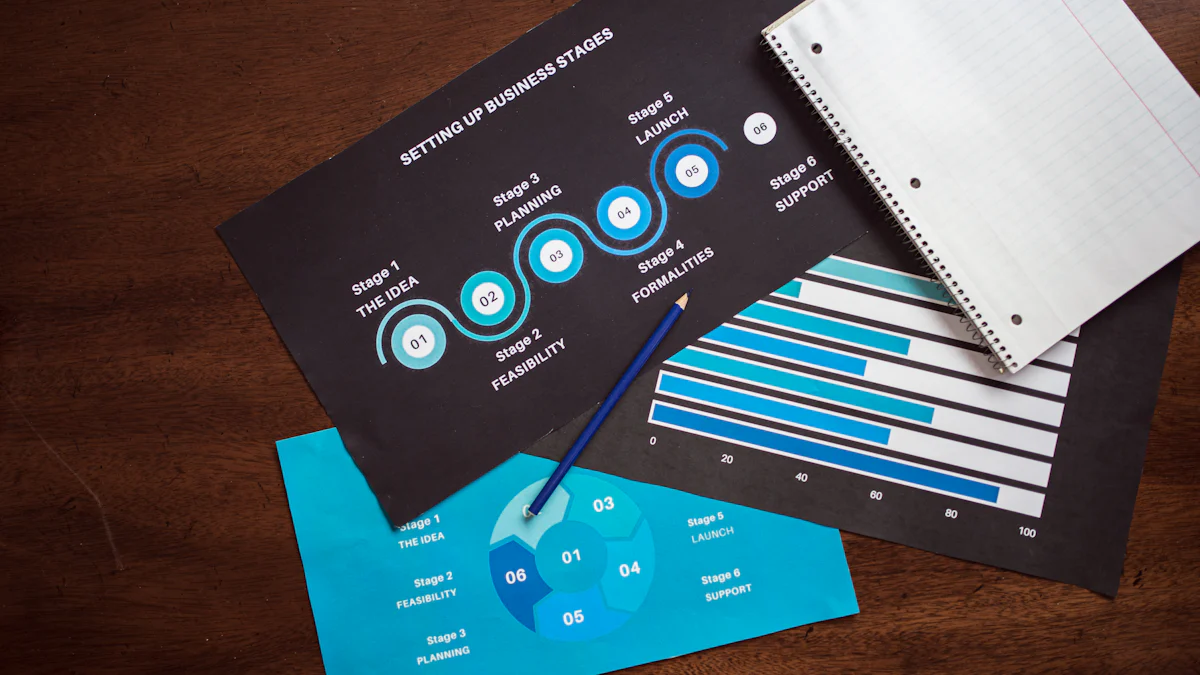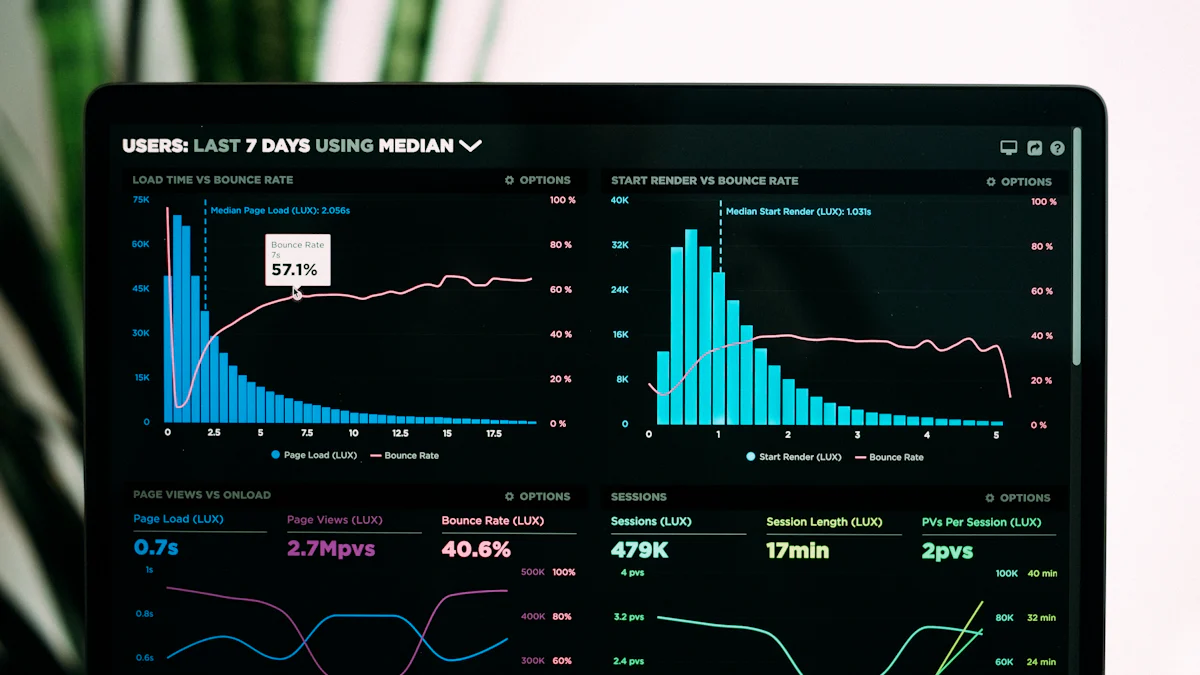KPIs for Influencer Marketing That Drive Results

When it comes to influencer marketing, tracking the right KPIs for influencer marketing is the secret to success. Metrics like engagement, reach, conversions, audience growth, and ROI give you a clear picture of how well your campaigns perform. Did you know 64% of brands prioritize measuring influencer marketing performance? That’s because these KPIs for influencer marketing help you evaluate impact, refine strategies, and maximize results. Whether you’re working with nano-influencers or celebrities, focusing on the right data—like engagement rates or impressions—ensures your efforts deliver measurable value. Ready to make your campaigns more effective? Start with the right KPIs for influencer marketing.
Pro Tip: Use tools like Google Analytics or social media insights to track and analyze your KPIs for influencer marketing effectively.
Understanding KPIs for Influencer Marketing
What Are KPIs?
Key performance indicators, or KPIs, are measurable metrics that help you track the success of your influencer marketing campaigns. Think of them as a roadmap showing whether your efforts are heading in the right direction. In influencer marketing, KPIs can include metrics like reach, impressions, engagement, and conversions. For example:
- Reach and impressions tell you how many people saw the content and how often it appeared.
- Engagement measures audience interaction through likes, comments, and shares.
- Conversions track actions like sales or sign-ups driven by the campaign.
By focusing on these metrics, you can better understand how well your campaigns perform and where adjustments might be needed.
Why KPIs Matter in Influencer Marketing Campaigns
Tracking influencer marketing KPIs is essential for evaluating your campaign’s impact. Without clear benchmarks, it’s hard to know if your efforts are paying off. KPIs connect the dots between influencer-generated traffic and actual results, like sales or increased brand awareness.
| KPI Type | Importance |
|---|---|
| Measurable Data | Helps evaluate performance and impact |
| Optimization | Guides improvements for ongoing campaigns |
| Data-driven Decisions | Supports achieving business goals |
By monitoring these KPIs, you gain a clear picture of what’s working and what’s not. This insight helps you make smarter decisions and optimize future campaigns.
Benefits of Tracking Influencer Marketing KPIs
When you track KPIs, you unlock several benefits that can transform your campaigns:
- You can optimize strategies to ensure they resonate with your audience.
- It helps you drive meaningful interactions and build stronger connections.
- You’ll achieve tangible outcomes, like increased sales or brand awareness.
- It allows you to allocate budgets effectively and focus on what works.
Tracking KPIs isn’t just about numbers. It’s about understanding your audience, refining your approach, and ensuring your influencer partnerships deliver real value. Whether your goal is boosting brand awareness or driving conversions, KPIs are your secret weapon for success.
Key KPIs for Influencer Marketing Campaigns

Engagement Metrics
Likes, Comments, and Shares
Engagement metrics are the heartbeat of influencer marketing campaigns. They show how well your content resonates with the audience. Metrics like likes, comments, and shares reveal how actively followers interact with the influencer’s posts. For example:
- Engagement rate measures the ratio of interactions (likes, comments, shares) to views.
- Influencer reach reflects the number of unique individuals who see the content.
- Sales often correlate with higher engagement, as active participation builds trust and loyalty.
When followers engage with posts, it strengthens their connection to your brand. This interaction often leads to conversions. Successful campaigns, like Fiji Water’s collaboration with Danielle Bernstein, generated over 2000 pieces of user-generated content and 190K Instagram posts, amplifying brand visibility and engagement.
Tip: High engagement rates indicate content effectiveness. Use these insights to refine future campaigns.
Save and Bookmark Rates
Save and bookmark rates are often overlooked but incredibly valuable. These metrics show how many users find the content so useful or inspiring that they want to revisit it later. A high save rate suggests your content is not just engaging but also meaningful. It’s a sign that your campaign is leaving a lasting impression on the audience.
Reach and Impressions
Audience Reach
Reach measures how many unique users see your content. It’s a critical influencer marketing KPI for assessing brand awareness. If your goal is to expand your audience, tracking reach helps you understand how many people are exposed to your message. Tools like Instagram Insights or Google Analytics can help you monitor this metric effectively.
Impressions and Visibility
Impressions, on the other hand, count how many times your content is displayed, even if the same user sees it multiple times. While reach focuses on unique views, impressions highlight the frequency of exposure. Both metrics are essential for understanding your campaign’s visibility.
| Reach | Impressions |
|---|---|
| Measures unique users | Measures total views |
| Indicates exposure | Indicates engagement potential |
Note: A high number of impressions with a lower reach might mean your content is being repeatedly viewed by the same audience, which could indicate strong interest or overexposure.
Conversion Metrics
Sales and Revenue
Sales and revenue are the ultimate indicators of a campaign’s success. They show how well your influencer partnerships drive tangible results. By sharing unique promo codes or affiliate links with influencers, you can directly track the sales they generate. For instance, 50% of marketers use trackable links to measure conversions. This approach ensures you know exactly which influencers deliver the best ROI.
Website Traffic and Sign-ups
Website traffic and sign-ups are equally important conversion metrics. They reveal how many users visit your site or subscribe to your services after seeing influencer content. Tools like Google Analytics and UTM parameters make it easy to track these actions. A spike in traffic during a campaign often signals that your content is effective in driving interest and intent.
Pro Tip: Combine sales data with website traffic insights to get a complete picture of your campaign’s performance.
Audience Growth
Social Profile Growth
Audience growth is a key indicator of how well your influencer marketing campaign is performing. Tracking the growth of an influencer’s followers during the campaign period gives you a clear picture of their impact. A significant increase in followers shows that the campaign is resonating with the audience.
Here’s what you should monitor:
- Follower count reflects the size of the influencer’s audience and their potential reach.
- Growth rate shows how quickly their follower count is increasing. A steady rise is a good sign, but an unusually high rate might indicate fake followers.
When you see consistent growth, it means the campaign message is connecting with people. This growth not only boosts brand awareness but also expands your potential customer base.
New Audience Demographics
Understanding who your new followers are is just as important as tracking their numbers. Analyzing audience demographics helps you see if your campaign is attracting the right people. Are they within your target market? Do they align with your brand values?
By studying metrics like age, location, and interests, you can refine your future campaigns. For example, if you notice a spike in engagement rates from a specific demographic, you can tailor your content to appeal to them even more. This insight ensures your influencer marketing KPIs align with your overall goals.
ROI (Return on Investment)
Calculating ROI
Measuring ROI in influencer marketing isn’t always straightforward, but it’s essential. You need to consider both direct and indirect returns. Direct ROI includes sales and conversions, while indirect ROI covers metrics like engagement rate and brand awareness.
Here’s a simple formula to calculate ROI:
(Total Revenue – Total Costs) / Total Costs x 100 = ROI (%)
Start by calculating all costs, including influencer fees, product samples, and software expenses. Then, measure returns like sales or website traffic. Plug these numbers into the formula to get a clear picture of your campaign’s profitability.
Cost-Effectiveness of Influencer Campaigns
Influencer marketing is often more cost-effective than traditional advertising. It’s estimated to be 10.52 times more efficient than paid media. Metrics like Earned Media Value (EMV) help you assess this cost-effectiveness. EMV calculates the value of reach and engagement, giving you a better understanding of your campaign’s worth.
To maximize ROI, focus on partnering with influencers whose audience aligns with your target market. Use affiliate links or promo codes to track conversions accurately. Building long-term relationships with high-performing influencers can also boost your results.
By analyzing ROI metrics, you can make smarter decisions about budget allocation and campaign strategies. This ensures your influencer marketing KPIs drive measurable success.
Choosing the Right KPIs for Your Influencer Marketing Campaign
Aligning KPIs with Campaign Objectives
Your campaign objectives should guide your choice of KPIs. Are you aiming to boost sales, increase engagement, or grow brand awareness? Each goal requires a different focus. For example, if your objective is to drive sales, track conversion metrics like revenue or website traffic. On the other hand, if you want to build awareness, prioritize reach and impressions.
Start by asking yourself: What do I want to achieve with this influencer marketing campaign? Once you define your goals, it becomes easier to align the right KPIs. This alignment ensures your efforts stay focused and measurable.
Tip: Clear objectives help you avoid wasting time on irrelevant metrics. Always tie your KPIs back to your campaign’s purpose.
Prioritizing Metrics Based on Target Audience
Your target audience plays a huge role in determining which KPIs matter most. Different audiences respond to content in unique ways. For instance, younger audiences might engage more through likes and shares, while professionals might prefer meaningful comments or saves.
“When it comes to KPIs, there's a lot of things to look at. What matters depends on what your objectives are. This will change the metrics that you want to be looking at.” - Bren Daniel, Head of Influencer & Partnerships at Caraway.
To prioritize effectively:
- Group campaigns by their objectives and evaluate which ones drive the best return.
- Compare spend efficiency metrics across platforms to decide where to invest.
- Map influencers to your goals and assess their cost versus performance.
“It's always good to partner with your tech team to help you set up tracking for your campaign metrics, because you also want to make sure that whatever you're tracking is consistent with all the other marketing platforms.” - Milan Freeman, Influencer Marketing Expert and Strategist.
Balancing Short-Term and Long-Term Goals
Balancing short-term wins with long-term growth is key to a successful strategy. Short-term goals might include immediate sales or engagement boosts. Long-term goals could focus on building brand awareness or fostering customer loyalty.
To strike this balance:
- Define both short-term and long-term goals upfront.
- Tailor your influencer marketing campaign to address both types of objectives.
- Use short-term metrics like sales to measure immediate success, while tracking long-term metrics like audience growth to gauge sustained impact.
By keeping both perspectives in mind, you ensure your campaigns deliver quick results while contributing to your brand’s future success.
Tools and Methods for Tracking Influencer Marketing KPIs

Social Media Analytics Tools
Social media analytics tools are your best friends when it comes to tracking influencer marketing KPIs. These tools help you measure engagement, reach, and audience behavior directly on the platforms where your campaigns run. Here are some popular options:
- Google Analytics 4 (GA4): Tracks new visitors and engagement rates from influencer campaigns.
- Instagram Insights and TikTok Analytics: Built-in tools that provide data on likes, comments, shares, and audience demographics.
- Hootsuite and Sprout Social: Great for managing multiple platforms and analyzing performance trends.
- Socialinsider: Perfect for analyzing content pillars and understanding what resonates with your audience.
These tools simplify data collection and give you actionable insights. For example, Instagram Insights can show you which posts drive the most engagement, helping you refine your strategy.
Tip: Use native analytics tools for platform-specific insights and pair them with external tools for a broader view of your campaign’s performance.
Third-Party Influencer Marketing Platforms
Third-party platforms take your KPI tracking to the next level. They combine influencer identification, campaign management, and analytics into one place. Here’s how they can help:
- Traackr: Offers detailed insights into influencer audience demographics and behaviors.
- Upfluence: Helps you find the right influencers, manage campaigns, and analyze results.
- Statusphere: Automates tracking and provides real-time data aggregation for better decision-making.
These platforms save you time and effort by centralizing data. For instance, Traackr can show you how an influencer’s audience aligns with your target market, while Upfluence tracks conversions and engagement.
Note: Third-party tools often integrate with native analytics, giving you a complete picture of your campaign’s impact.
Using UTM Codes and Custom Links
UTM codes and custom links are essential for tracking influencer-driven traffic and conversions. They let you see exactly which influencers bring in the most value. Here’s why you should use them:
- Accurate Tracking: UTM tags show which influencers drive traffic and conversions.
- Better Decision-Making: Insights from UTM data help you refine your marketing strategies.
- Improved ROI: Tracking performance ensures you allocate budgets effectively.
- Enhanced Reporting: UTM codes make it easy to generate detailed performance reports.
For example, you can create a unique UTM link for each influencer. When users click the link, you’ll know exactly where the traffic came from. This data helps you identify top-performing influencers and optimize future campaigns.
Pro Tip: Share performance data with influencers to foster collaboration and improve campaign outcomes.
Manual Tracking and Reporting
Manual tracking and reporting might sound old-school, but it can still be a powerful way to monitor your influencer marketing KPIs. It gives you complete control over the data and helps you dive deep into campaign performance. However, it’s not without its hurdles. Let’s break it down.
Why should you consider manual tracking?
Manual tracking offers several benefits that can elevate your campaigns:
- ROI Measurement: You can justify your marketing budget by directly linking influencer efforts to revenue.
- Campaign Optimization: By analyzing the data yourself, you can make real-time adjustments to improve results.
- Influencer Selection: It helps you identify influencers who bring genuine engagement, not just vanity metrics.
- Strategy Refinement: You’ll gain insights to fine-tune future campaigns for better outcomes.
- Performance Benchmarking: Compare your results with competitors to see where you stand.
- Budget Efficiency: Spot cost-effective partnerships and focus your resources where they matter most.
Tip: Use spreadsheets to organize data like engagement rates, traffic, and conversions. This makes it easier to spot trends and patterns.
What are the challenges?
While manual tracking has its perks, it’s not always smooth sailing. Here are some common obstacles:
- Tracking Metrics Across Platforms: Each platform uses different metrics, making it tricky to combine data.
- Attribution Complexity: It’s hard to pinpoint which influencer touchpoint drove a specific action.
- ROI Calculation Challenges: Intangible benefits like brand awareness are tough to quantify.
- Real-time Monitoring Issues: Manual tracking takes time and can lead to errors if not done carefully.
If you’re managing multiple campaigns, these challenges can feel overwhelming. But with a structured approach, you can minimize the hassle. Start by focusing on the most critical KPIs and track them consistently.
Pro Tip: Double-check your data entries to avoid mistakes. Accuracy is key when you’re manually tracking performance.
Manual tracking might not be the fastest method, but it’s a great way to stay hands-on with your campaigns. It helps you understand the numbers behind the results, giving you the insights you need to make smarter decisions.
Tracking the right KPIs for influencer marketing campaigns is essential for success. Metrics like engagement, reach, conversions, audience growth, and ROI give you measurable insights into your campaign’s performance. They help you understand what works, optimize strategies, and allocate budgets effectively.
When you monitor KPIs, you can evaluate your campaign’s impact and make data-driven decisions. For example, tracking conversions and follower growth shows how influencers connect with your audience. Meanwhile, engagement metrics reveal how well your content resonates. These insights ensure your influencer marketing campaign delivers both immediate results and long-term value.
Choose KPIs that align with your goals and use tools like social media analytics or UTM codes to track them. By focusing on the right data, you’ll maximize your campaign’s potential and drive meaningful outcomes.
FAQ
What are the most important KPIs for influencer marketing?
The key KPIs include engagement metrics (likes, comments, shares), reach, impressions, conversions (sales, website traffic), audience growth, and ROI. These metrics help you measure campaign success and optimize strategies for better results.
Tip: Focus on KPIs that align with your campaign goals for maximum impact.
How do I calculate ROI for influencer campaigns?
Use this formula:
(Total Revenue – Total Costs) / Total Costs x 100 = ROI (%)
Include all expenses like influencer fees and software costs. Then, track returns like sales or traffic to measure profitability.
Which tools can I use to track influencer marketing KPIs?
You can use tools like:
- Google Analytics for traffic and conversions.
- Instagram Insights for engagement and reach.
- Hootsuite for multi-platform tracking.
- Traackr for influencer-specific data.
Pro Tip: Combine native analytics with third-party tools for deeper insights.
How do I know if an influencer is a good fit for my brand?
Look at their audience demographics, engagement rates, and content style. Ensure their followers align with your target market. Check for authenticity by analyzing their follower growth and interaction quality.
Can I track KPIs manually without tools?
Yes, you can! Use spreadsheets to log metrics like engagement, traffic, and conversions. While it’s time-consuming, manual tracking gives you full control over the data.
Note: Double-check entries to avoid errors and ensure accuracy.
See Also
Decoding The Return On Investment In Influencer Marketing
Key Influencer Marketing Statistics To Enhance Your Strategy
Best Influencer Marketing Platforms To Boost E-commerce Growth
Selecting The Right TikTok Influencer Marketing Firm For You
